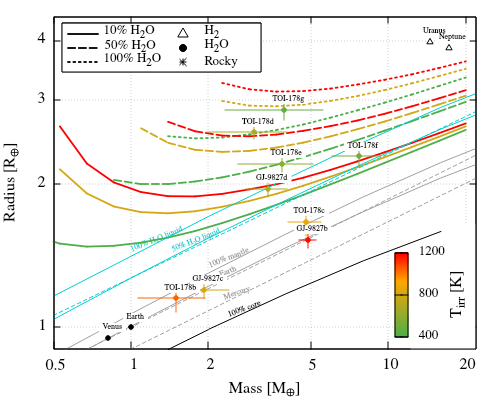- 1Laboratoire d'Astrophysique de Marseille, Aix-Marseille Université, Marseille, France (artem.aguichine@lam.fr)
- 2Laboratoire d'Astrophysique de Marseille, Aix-Marseille Université, Marseille, France (olivier.mousis@lam.fr)
- 3Laboratoire d'Astrophysique de Marseille, Aix-Marseille Université, Marseille, France (magali.deleuil@lam.fr)
- 4LATMOS, Université Paris-Saclay, Guyancourt, France (emmanuel.marcq@latmos.ipsl.fr)
Water-rich planets should be ubiquitous in the universe. Among the current exoplanet populations, many of those worlds are subject to important irradiation from their host star. As a consequence, water-rich worlds display supercritical water layer surrounded by an extended steam atmosphere making them good candidates for matching the observed mass-radius distribution of sub-Neptunes [1]. Here we describe a model that computes a realistic structure for water-rich planets by combining an interior model with an updated equation of state (EoS) for water, and an atmospheric model that takes into account radiative transfer. Our model has been applied to the GJ 9827 system as a test case and indicates Earth- or Venus-like interiors for planets b and c, respectively. Planet d could be an irradiated ocean planet with a water mass fraction of ∼20 ± 10%. We also provide mass-radius relationships for water-rich planets and their analytical expression. This allows one to directly retrieve a wide range of planetary compositions, without the requirement to run the model. The possible existence of such planets is discussed in light of atmospheric loss processes, suggesting that some sub-Neptunes are the outcome of planets that lost their H/He reservoirs.

Figure 1. Mass-radius relationships produced by our model (green, yellow and red thick lines) [2], compared to mass-radius relationships of planets with only condensed phases and no atmosphere (black, grey and light blue thin lines) [3,4]. A few planets of the solar system, the GJ-9827 system and the TOI-178 system are shown as well [5,6].
[1] Mousis, O., Deleuil, M., Aguichine, A., et al. 2020, ApJL, 896, L22.
[2] Aguichine, A., Mousis, O., Deleuil, M., et al. 2021, accepted in ApJ.
[3] Zeng, L., Sasselov, D. D., & Jacobsen, S. B. 2016, ApJ, 819, 127.
[4] Brugger, B., Mousis, O., Deleuil, M., et al. 2017, ApJ, 850, 93.
[5] Kosiarek, M. R., Berardo, D. A., Crossfield, I. J. M., et al. 2021, AJ, 161, 47.
[6] Leleu, A., Alibert, Y., Hara, N. C., et al. 2021, A&A, 649, A26.
How to cite: Aguichine, A., Mousis, O., Deleuil, M., and Marcq, E.: Modeling the structure of irradiated ocean planets - implications for mass-radius relationships, Europlanet Science Congress 2021, online, 13–24 Sep 2021, EPSC2021-27, https://doi.org/10.5194/epsc2021-27, 2021.

